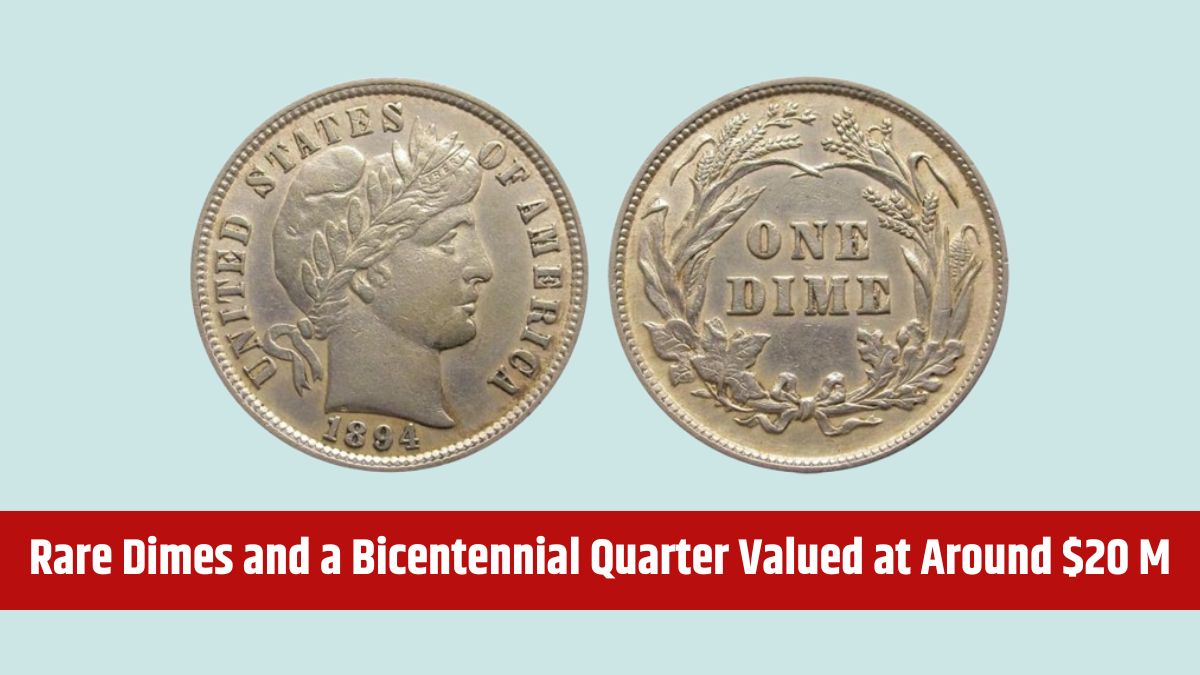In the vast ocean of U.S. coins, a few rare treasures stand out for their historical significance and jaw-dropping value. Some of these rare coins, potentially worth millions, could be hiding in your pocket change.
This article examines three such coins: the 1894-S Barber Dime, the 1916-D Mercury Dime, and the 1976 Bicentennial Quarter, which have captured the attention of collectors and investors alike.
1894-S Barber Dime
The 1894-S Barber Dime is one of the rarest and most sought-after coins in American numismatics. Only 24 dimes were minted in 1894 at the San Francisco Mint, making it an incredibly rare find.
The Mystery Behind Its Rarity
There are several theories about why so few were minted:
- They were test pieces for the annual audit.
- The Mint Director, John Daggett, had them made as gifts for banker friends.
- They were struck to balance a bullion account.
Current Value
As of 2025, the 1894-S Barber Dime is valued between $1.9 million and $2.5 million, depending on its condition.
Some notable sales include:
- In 2016, an example graded Proof-66 by PCGS sold for $1,997,500.
- A specimen observed in a school cafeteria in the 1950s was sold for over $2 million in 2024.
Identifying Characteristics
To identify an 1894-S Barber Dime, look for:
- The “Barber” design featuring Liberty’s head on the obverse.
- The ‘S’ mint mark below the wreath on the reverse.
- Proof-like surfaces, as all known specimens were struck as proofs.
1916-D Mercury Dime
The 1916-D Mercury Dime was the first year of Adolph A. Weinman’s “Mercury” dime design, which lasted until 1945. With only 264,000 dimes minted at the Denver Mint, it became one of the rarest dimes of the 20th century.
Current Market Value
As of 2025, the value of a 1916-D Mercury Dime depends on its condition:
| Condition | Estimated Value |
|---|---|
| Poor (well-worn) | $1,000 |
| Fine | $10,000 – $20,000 |
| Uncirculated | $100,000 – $250,000+ |
Key Identification Features
To verify a 1916-D Mercury Dime, check for:
- The “Mercury” or Winged Liberty Head design on the obverse.
- The ‘D’ mint mark on the reverse, below the fasces.
- The date 1916 clearly visible on the obverse.
1976 Bicentennial Quarter
The 1976 Bicentennial Quarter was minted to celebrate America’s 200th anniversary. While most of these coins are common, certain error coins from this series are highly valuable.
Types of Valuable Errors
- Double Die Errors – Parts of the design appear doubled due to a misaligned strike.
- Off-Center Strikes – Coins struck off-center, resulting in missing design parts.
- Silver Proof Errors – Rare cases where silver proofs were mistakenly struck on copper-nickel planchets.
Current Market Values
While most Bicentennial Quarters are worth face value, rare error coins can fetch impressive sums:
| Error Type | Estimated Value |
|---|---|
| Double Die Errors | $100 – $25,000 |
| Off-Center Strikes | $100 – $5,000 |
| Silver Proof Errors | Up to $100,000+ |
How to Identify Valuable Specimens
Look for:
- Doubling in the lettering or design elements.
- Misaligned or partial designs, indicating off-center strikes.
- Unusual weight or color, which might suggest a planchet error.
FAQs
How much is the 1894-S Barber Dime worth?
The 1894-S Barber Dime is valued between $1.9 million and $2.5 million.
Why is the 1916-D Mercury Dime rare?
Only 264,000 were minted, making it a key date in the Mercury Dime series.
What makes a 1976 Bicentennial Quarter valuable?
Error coins like double die, off-center strikes, and silver proof errors increase value.
How can I tell if I have a rare dime?
Check the date, mint mark, and any unusual features like doubling or errors.
Where can I sell valuable coins?
Rare coins can be sold at auctions, coin dealers, and online marketplaces.

















